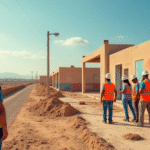Understanding the Risk of Hidden Defects in Real Estate
Acquiring a property is the result of years of hard work and dedication to achieve this goal; however, there’s a risk that the dream could turn into a nightmare if the property has hidden defects. It’s crucial to ensure there are no underlying issues before making the final decision.
Expert Insights on Hidden Defects
According to Tony Hanná Grayeb, General Director of the platform Tiburones Inmobiliarios, while it’s challenging to estimate the percentage of cases with hidden defects in a property, this is quite common within real estate transactions, whether for new or used properties.
Manuel Ventosa, General Director of Vega Consultores, a firm offering such certifications for developers, brokers, sellers, and buyers, explains: “It’s a quality certification for the property, providing security for a purchase or sale. It’s a preventive system rather than a corrective one.”
Scope of Property Certification
- Visual indicators of construction stability and finishing touches
- Technical inspection of electrical installations, air conditioning systems, water and drainage, among others
- Installed equipment, access controls, and emergency systems
- Installations in common areas
- Fire protection devices, elevators, irrigation systems, and others
“Any type of building can be certified… Ultimately, it’s the same variables related to construction,” Ventosa pointed out.
The Certification Process
Ventosa detailed that the certification process involves contracting and initiating the procedure, submitting technical documents, plans, and general specifications. An inspection visit is then scheduled.
During the first technical inspection, a review of masonry, finishing touches in installations, and other aspects is conducted, resulting in an initial report of any issues. A second visit verifies if all observations have been addressed, leading to the conformity certificate for the property.
A third visit may occur if issues persist from previous inspections, emphasizing the importance of resolving problems comprehensively.
Cost of Certification
Ventosa mentioned that the typical certification cost is 1% of the property’s value. For instance, a home valued around 3 million pesos would have a certification cost of approximately 30,000 pesos.
The expert highlighted that the certification applies not only to real estate purchases but also to rental processes.
Key Questions and Answers
- What are hidden defects in real estate? Hidden defects refer to unnoticed issues within a property, such as structural problems or faulty installations.
- Why is property certification important? Certification ensures the quality and safety of a property, providing security for both buyers and renters.
- What does the certification process entail? The process involves submitting technical documents, plans, and specifications for inspection. Issues are addressed in subsequent visits, culminating in a conformity certificate.
- How much does property certification cost? The cost is typically 1% of the property’s value.






